2023 HYUNDAI IONIQ 6 light
[x] Cancel search: lightPage 121 of 582

3
3-27
Larger children
Children under age 13 and who are too
large for a booster seat should always
occupy the rear seat and use the available
lap/shoulder belts. A seat belt should lie
across the upper thighs and be snug
across the shoulder and chest to restrain
the child safely. Check belt fit
periodically. A child’s squirming could put
the belt out of position. In the event of an
accident, children are afforded the best
safety restrained by a proper Child
Restraint System in the rear seats.
If a larger child over age 13 must be seated
in the front seat, the child must be
securely restrained by the available
lap/shoulder belt and the seat should be
placed in the rearmost position.
If the shoulder belt portion slightly
touches the child’s neck or face, try
placing the child closer to the center of
the vehicle. If the shoulder belt still
touches their face or neck, they need to
be returned to an appropriate booster
seat in the rear seat.
WARNING • Always make sure larger children’s seat belts are worn and properly adjusted.
• NEVER allow the shoulder belt to contact the child’s neck or face.
• Do not allow more than one child to use a single seat belt.
Seat belt use and injured people
A seat belt should be used when an
injured person is being transported.
Consult a physician for specific
recommendations.
One person per belt
Two people (including children) should
never attempt to use a single seat belt.
This could increase the severity of injuries
in case of an accident.
Do not lie down
Sitting in a reclined position when the
vehicle is in motion can be dangerous.
Even when buckled up, the protections of
your restraint system (seat belts and/or
airbags) is greatly reduced by reclining
your seatback.
Seat belts must be snug against your hips
and chest to work properly.
During an accident, you could be thrown
into the seat belt, causing neck or other
injuries.
The more the seat back is reclined, the
greater the chance for the passenger’s
hips to slide under the lap belt or the
passenger’s neck to strike the shoulder
belt.
WARNING • NEVER ride with a reclined seatback when the vehicle is moving.
• Riding with a reclined seatback increases your chance of serious or
fatal injuries in the event of a collision or
sudden stop.
• Driver and passengers should always sit well back in their seats with the
seatbacks upright and should be belted
properly.
Care of Seat Belts
Seat belt systems should never be
disassembled or modified. In addition,
care should be taken to assure that seat
belts and belt hardware are not damaged
by seat hinges, doors or other abuse.
Periodic inspection
All seat belts should be inspected
periodically for wear or damage of any
kind. Any damaged parts should be
replaced as soon as possible.
Hyundai_CE_en_US.book Page 27
Page 134 of 582
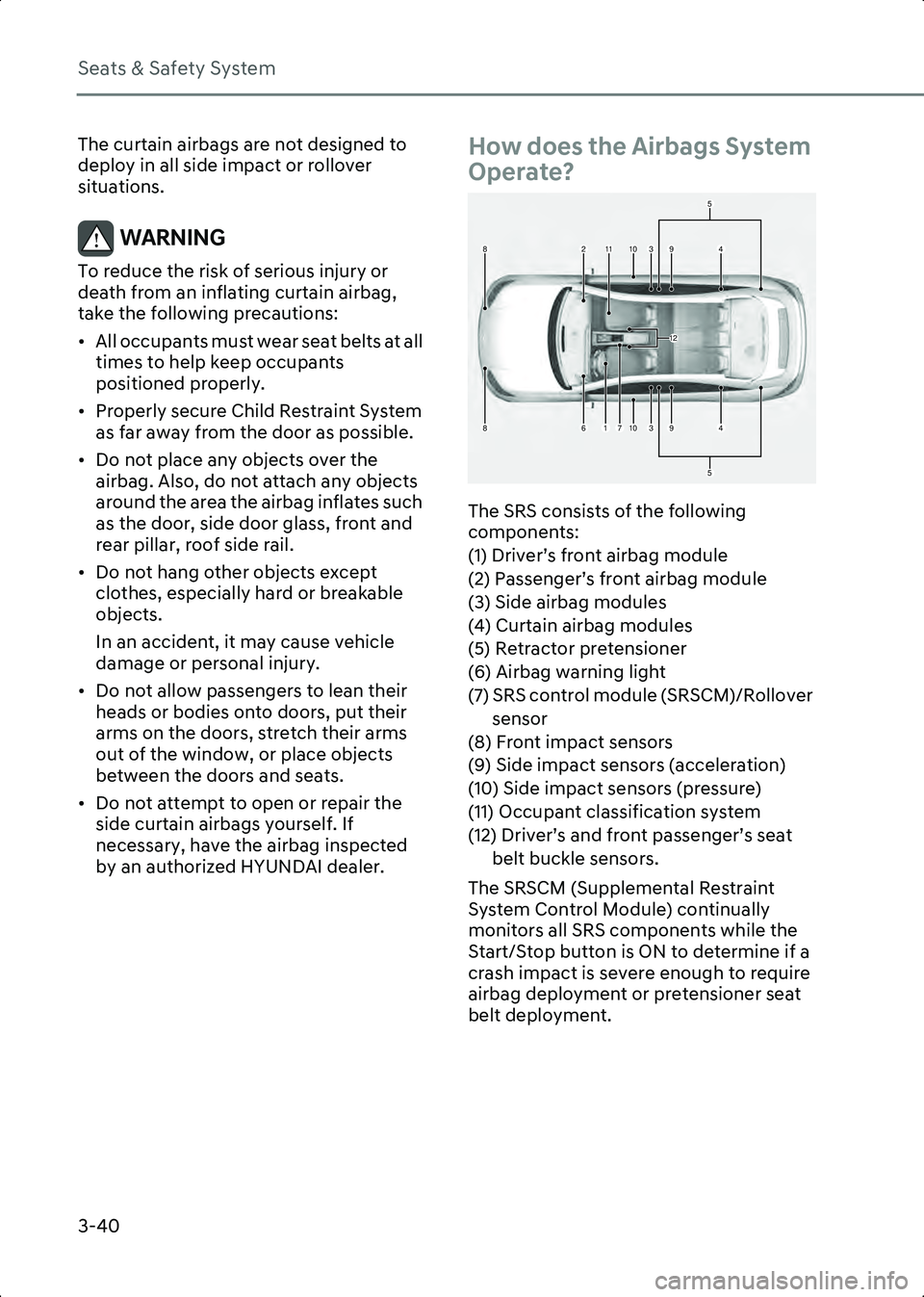
Seats & Safety System
3-40
The curtain airbags are not designed to
deploy in all side impact or rollover
situations.
WARNING To reduce the risk of serious injury or
death from an inflating curtain airbag,
take the following precautions:
• All occupants must wear seat belts at all times to help keep occupants
positioned properly.
• Properly secure Child Restraint System as far away from the door as possible.
• Do not place any objects over the airbag. Also, do not attach any objects
around the area the airbag inflates such
as the door, side door glass, front and
rear pillar, roof side rail.
• Do not hang other objects except clothes, especially hard or breakable
objects.
In an accident, it may cause vehicle
damage or personal injury.
• Do not allow passengers to lean their heads or bodies onto doors, put their
arms on the doors, stretch their arms
out of the window, or place objects
between the doors and seats.
• Do not attempt to open or repair the side curtain airbags yourself. If
necessary, have the airbag inspected
by an authorized HYUNDAI dealer.
How does the Airbags System
Operate?
A3002401
The SRS consists of the following
components:
(1) Driver’s front airbag module
(2) Passenger’s front airbag module
(3) Side airbag modules
(4) Curtain airbag modules
(5) Retractor pretensioner
(6) Airbag warning light
(7) SRS control module (SRSCM)/Rollover sensor
(8) Front impact sensors
(9) Side impact sensors (acceleration)
(10) Side impact sensors (pressure)
(11) Occupant classification system
(12) Driver’s and front passenger’s seat belt buckle sensors.
The SRSCM (Supplemental Restraint
System Control Module) continually
monitors all SRS components while the
Start/Stop button is ON to determine if a
crash impact is severe enough to require
airbag deployment or pretensioner seat
belt deployment.
4
5
5
11
1
23
37
8
86
9
49
10
10
12
Hyundai_CE_en_US.book Page 40
Page 135 of 582
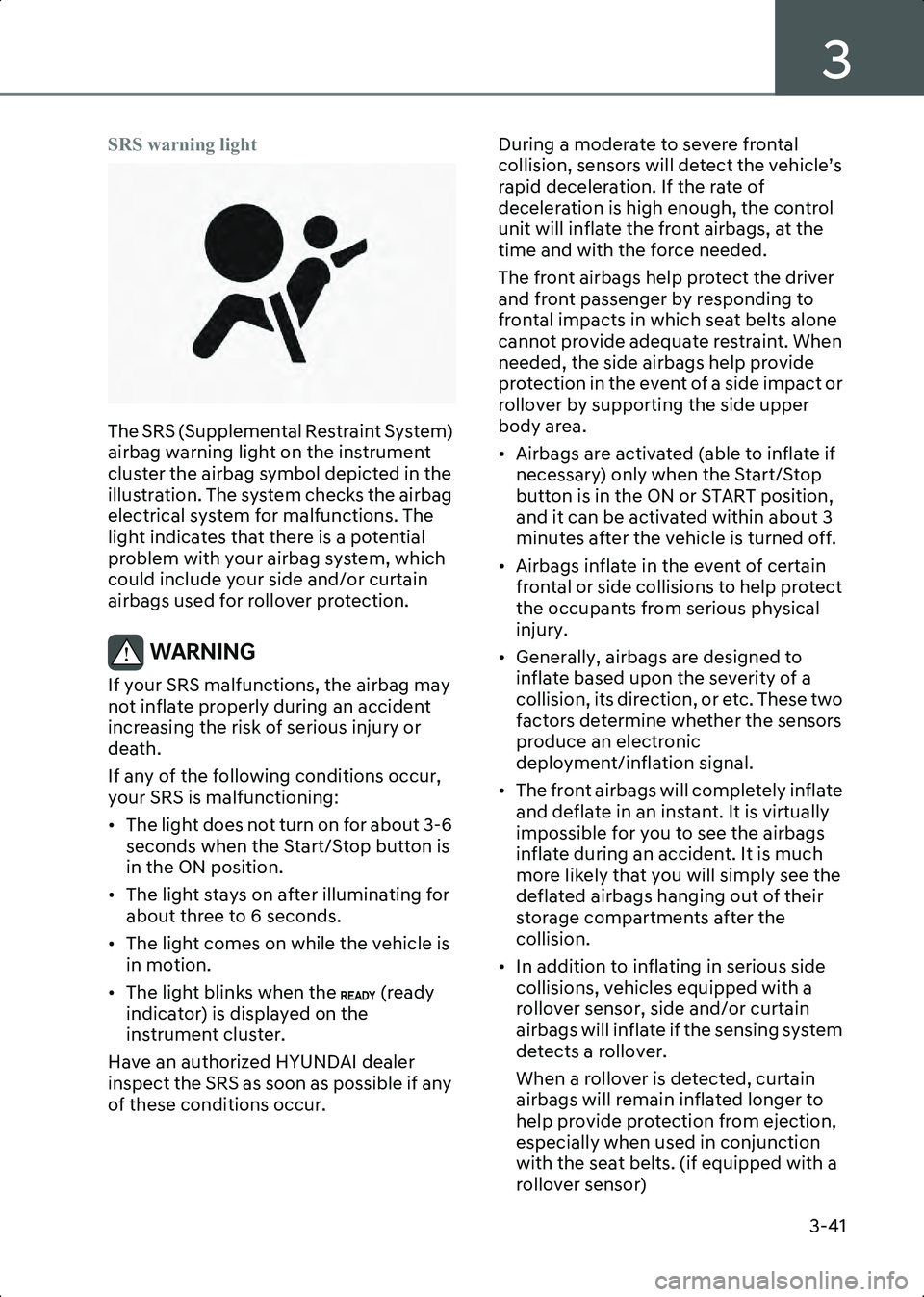
3
3-41
SRS warning light
B3002501
The SRS (Supplemental Restraint System)
airbag warning light on the instrument
cluster the airbag symbol depicted in the
illustration. The system checks the airbag
electrical system for malfunctions. The
light indicates that there is a potential
problem with your airbag system, which
could include your side and/or curtain
airbags used for rollover protection.
WARNING If your SRS malfunctions, the airbag may
not inflate properly during an accident
increasing the risk of serious injury or
death.
If any of the following conditions occur,
your SRS is malfunctioning:
• The light does not turn on for about 3-6 seconds when the Start/Stop button is
in the ON position.
• The light stays on after illuminating for about three to 6 seconds.
• The light comes on while the vehicle is in motion.
• The light blinks when the (ready indicator) is displayed on the
instrument cluster.
Have an authorized HYUNDAI dealer
inspect the SRS as soon as possible if any
of these conditions occur.
During a moderate to severe frontal
collision, sensors will detect the vehicle’s
rapid deceleration. If the rate of
deceleration is high enough, the control
unit will inflate the front airbags, at the
time and with the force needed.
The front airbags help protect the driver
and front passenger by responding to
frontal impacts in which seat belts alone
cannot provide adequate restraint. When
needed, the side airbags help provide
protection in the event of a side impact or
rollover by supporting the side upper
body area.
• Airbags are activated (able to inflate if
necessary) only when the Start/Stop
button is in the ON or START position,
and it can be activated within about 3
minutes after the vehicle is turned off.
• Airbags inflate in the event of certain frontal or side collisions to help protect
the occupants from serious physical
injury.
• Generally, airbags are designed to inflate based upon the severity of a
collision, its direction, or etc. These two
factors determine whether the sensors
produce an electronic
deployment/inflation signal.
• The front airbags will completely inflate and deflate in an instant. It is virtually
impossible for you to see the airbags
inflate during an accident. It is much
more likely that you will simply see the
deflated airbags hanging out of their
storage compartments after the
collision.
• In addition to inflating in serious side collisions, vehicles equipped with a
rollover sensor, side and/or curtain
airbags will inflate if the sensing system
detects a rollover.
When a rollover is detected, curtain
airbags will remain inflated longer to
help provide protection from ejection,
especially when used in conjunction
with the seat belts. (if equipped with a
rollover sensor)
Hyundai_CE_en_US.book Page 41
Page 138 of 582
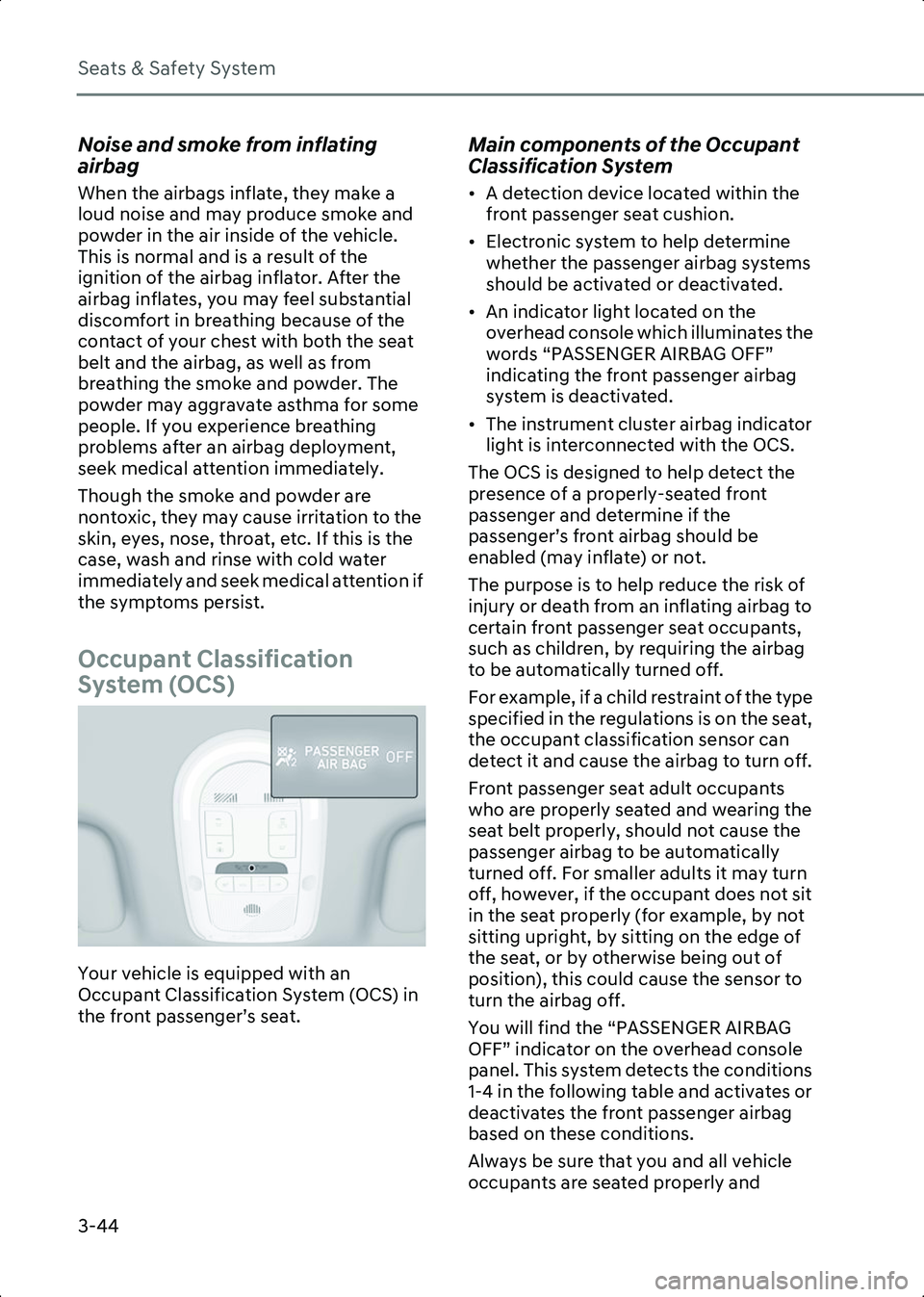
Seats & Safety System
3-44
Noise and smoke from inflating
airbag
When the airbags inflate, they make a
loud noise and may produce smoke and
powder in the air inside of the vehicle.
This is normal and is a result of the
ignition of the airbag inflator. After the
airbag inflates, you may feel substantial
discomfort in breathing because of the
contact of your chest with both the seat
belt and the airbag, as well as from
breathing the smoke and powder. The
powder may aggravate asthma for some
people. If you experience breathing
problems after an airbag deployment,
seek medical attention immediately.
Though the smoke and powder are
nontoxic, they may cause irritation to the
skin, eyes, nose, throat, etc. If this is the
case, wash and rinse with cold water
immediately and seek medical attention if
the symptoms persist.
Occupant Classification
System (OCS)
B3003102
Your vehicle is equipped with an
Occupant Classification System (OCS) in
the front passenger’s seat.
Main components of the Occupant
Classification System
• A detection device located within the front passenger seat cushion.
• Electronic system to help determine whether the passenger airbag systems
should be activated or deactivated.
• An indicator light located on the overhead console which illuminates the
words “PASSENGER AIRBAG OFF”
indicating the front passenger airbag
system is deactivated.
• The instrument cluster airbag indicator light is interconnected with the OCS.
The OCS is designed to help detect the
presence of a properly-seated front
passenger and determine if the
passenger’s front airbag should be
enabled (may inflate) or not.
The purpose is to help reduce the risk of
injury or death from an inflating airbag to
certain front passenger seat occupants,
such as children, by requiring the airbag
to be automatically turned off.
For example, if a child restraint of the type
specified in the regulations is on the seat,
the occupant classification sensor can
detect it and cause the airbag to turn off.
Front passenger seat adult occupants
who are properly seated and wearing the
seat belt properly, should not cause the
passenger airbag to be automatically
turned off. For smaller adults it may turn
off, however, if the occupant does not sit
in the seat properly (for example, by not
sitting upright, by sitting on the edge of
the seat, or by otherwise being out of
position), this could cause the sensor to
turn the airbag off.
You will find the “PASSENGER AIRBAG
OFF” indicator on the overhead console
panel. This system detects the conditions
1-4 in the following table and activates or
deactivates the front passenger airbag
based on these conditions.
Always be sure that you and all vehicle
occupants are seated properly and
Hyundai_CE_en_US.book Page 44
Page 140 of 582
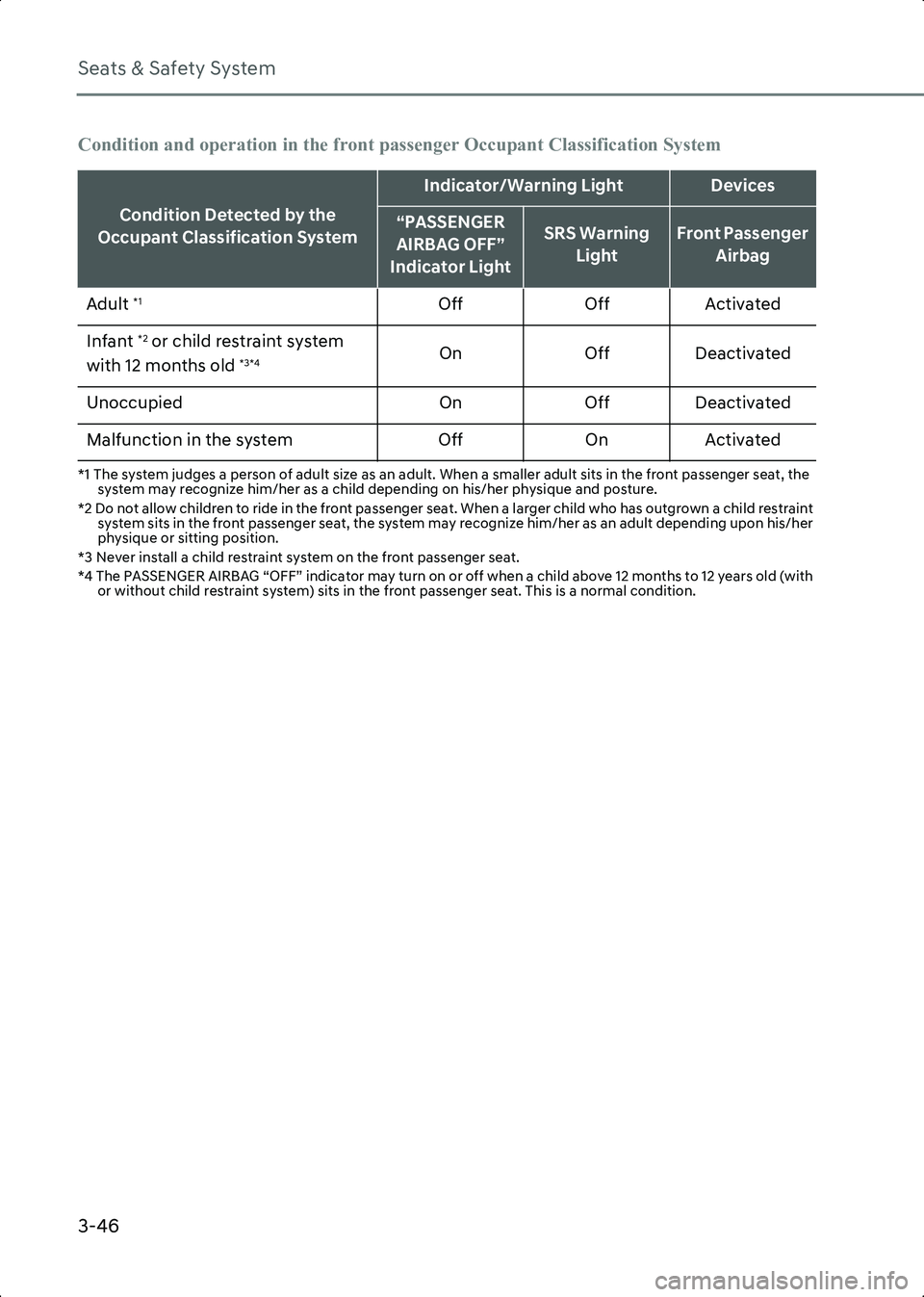
Seats & Safety System
3-46
Condition and operation in the front passenger Occupant Classification System
*1 The system judges a person of adult size as an adult. When a smaller adult sits in the front passenger seat, the system may recognize him/her as a child depending on his/her physique and posture.
*2 Do not allow children to ride in the front passenger seat. When a larger child who has outgrown a child restraint system sits in the front passenger seat, the system may recognize him/her as an adult depending upon his/her
physique or sitting position.
*3 Never install a child restraint system on the front passenger seat.
*4 The PASSENGER AIRBAG “OFF” indicator may turn on or off when a child above 12 months to 12 years old (with or without child restraint system) sits in the front passenger seat. This is a normal condition.
Condition Detected by the
Occupant Classification System
Indicator/Warning LightDevices
“PASSENGER AIRBAG OFF”
Indicator LightSRS Warning LightFront Passenger Airbag
Adult
*1Off OffActivated
Infant
*2 or child restraint system
with 12 months old *3*4On Off Deactivated
Unoccupied OnOff Deactivated
Malfunction in the system OffOnActivated
Hyundai_CE_en_US.book Page 46
Page 142 of 582
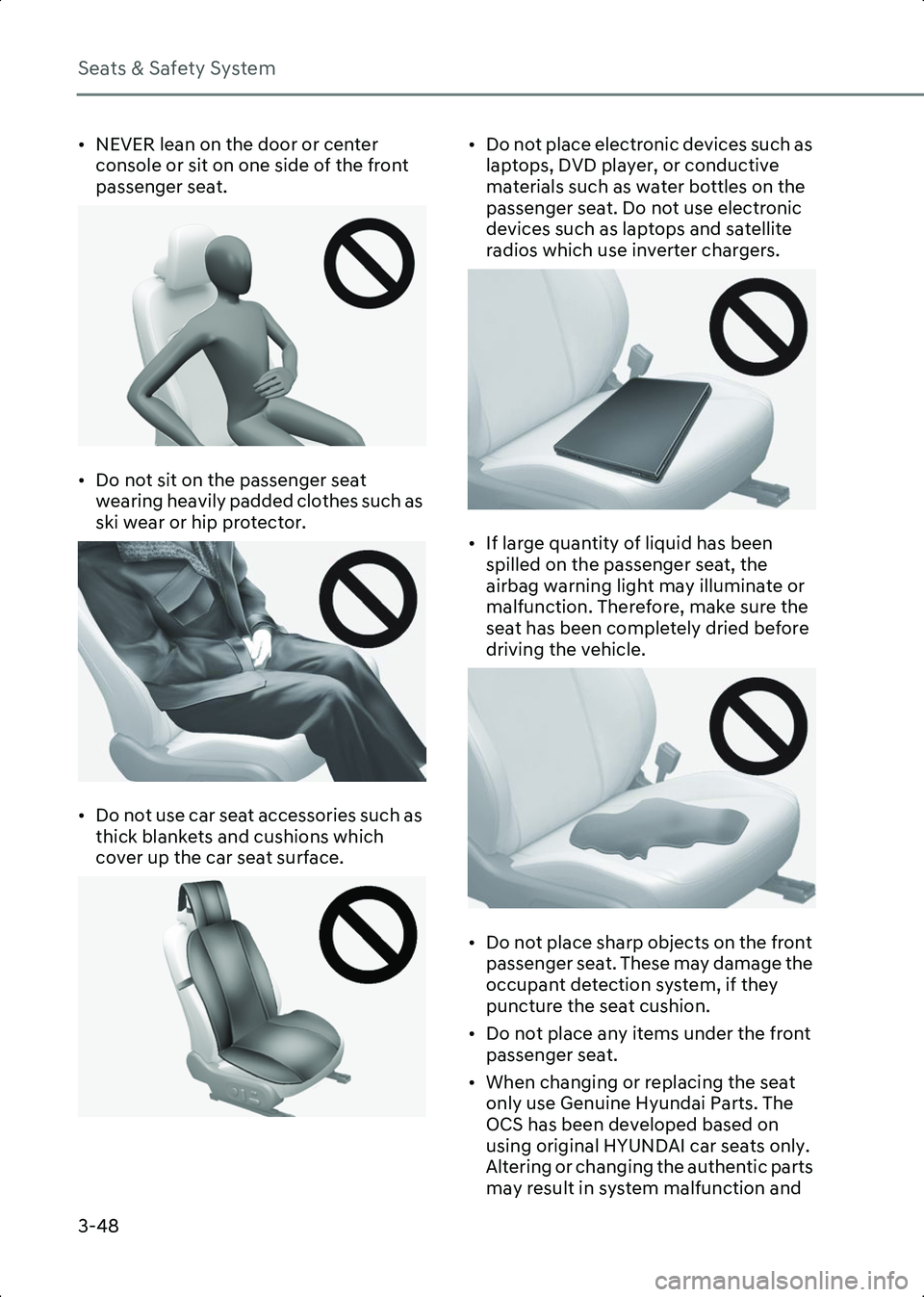
Seats & Safety System
3-48
• NEVER lean on the door or center console or sit on one side of the front
passenger seat.
B3003109
• Do not sit on the passenger seat wearing heavily padded clothes such as
ski wear or hip protector.
B3003110
• Do not use car seat accessories such as thick blankets and cushions which
cover up the car seat surface.
B3003112
• Do not place electronic devices such as laptops, DVD player, or conductive
materials such as water bottles on the
passenger seat. Do not use electronic devices such as laptops and satellite
radios which use inverter chargers.
B3003111
• If large quantity of liquid has been spilled on the passenger seat, the
airbag warning light may illuminate or
malfunction. Therefore, make sure the
seat has been completely dried before
driving the vehicle.
B3003113
• Do not place sharp objects on the front passenger seat. These may damage the
occupant detection system, if they
puncture the seat cushion.
• Do not place any items under the front passenger seat.
• When changing or replacing the seat only use Genuine Hyundai Parts. The
OCS has been developed based on
using original HYUNDAI car seats only.
Altering or changing the authentic parts
may result in system malfunction and
Hyundai_CE_en_US.book Page 48
Page 148 of 582

Seats & Safety System
3-54
B3003409
Front airbags may not inflate in rollover
accidents because front airbag
deployment would not provide additional
occupant protection.
The side and curtain airbags may inflate in
a rollover situation, when it is detected by
the rollover sensor.
B3003410
Airbags may not inflate if the vehicle
collides with objects such as utility poles
or trees, where the point of impact is
concentrated and the collision energy is
absorbed by the vehicle structure.
SRS Care
The SRS is virtually maintenance-free and
there are no parts you can safely service
by yourself. If the SRS airbag warning
light does not illuminate when the
Start/Stop button is in the ON position, or
continuously remains on, have the
system be immediately inspected by an
authorized HYUNDAI dealer.Any work on the SRS system, such as
removing, installing, repairing, or any
work on the steering wheel, the front
passenger’s panel, front seats and roof
rails be performed by an authorized
HYUNDAI dealer. Improper handling of
the SRS system may result in serious
personal injury.
WARNING To reduce the risk of serious injury or
death take the following precautions:
• Do not attempt to modify or disconnect
the SRS components or wiring,
including the addition of any kind of
badges to the pad covers or
modifications to the body structure.
• Do not place objects over or near the airbag modules on the steering wheel,
instrument panel, and the front
passenger’s panel above the glove box.
• Clean the airbag pad covers with a soft cloth moistened with plain water.
Solvents or cleaners could adversely
affect the airbag covers and proper
deployment of the system.
• Have the inflated airbags replaced by an authorized HYUNDAI dealer.
• If components of the airbag system must be discarded, or if the vehicle
must be scrapped, certain safety
precautions must be observed. Consult
an authorized HYUNDAI dealer for the
necessary information. Failure to follow
these precautions could increase the
risk of personal injury.
Hyundai_CE_en_US.book Page 54
Page 151 of 582
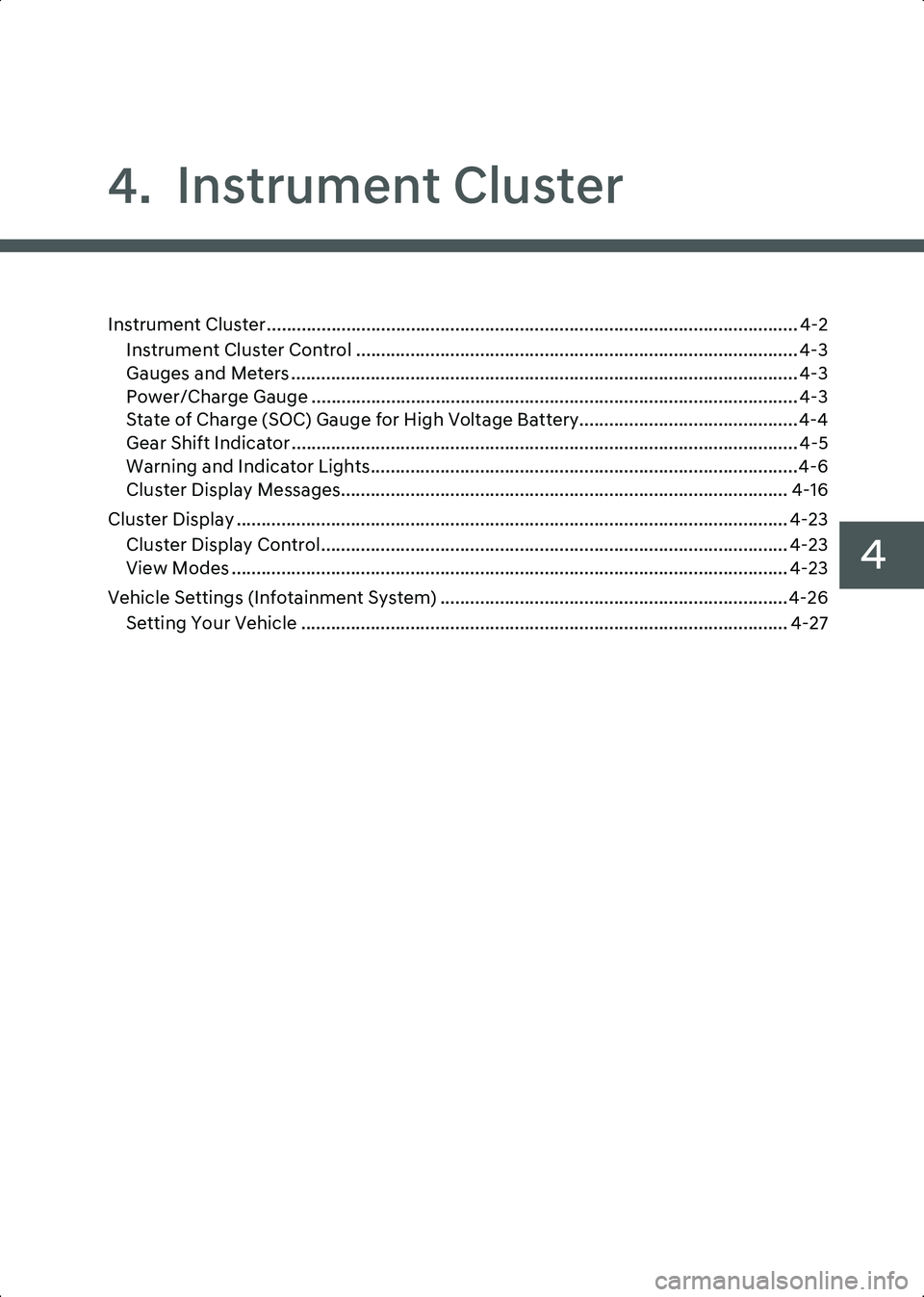
4
4. Instrument Cluster
Instrument Cluster........................................................................................................... 4-2Instrument Cluster Control ......................................................................................... 4-3
Gauges and Meters ...................................................................................................... 4-3Power/Charge Gauge .................................................................................................. 4-3
State of Charge (SOC) Gauge for High Voltage Battery............................................4-4
Gear Shift Indicator ...................................................................................................... 4-5Warning and Indicator Lights......................................................................................4-6Cluster Display Messages.......................................................................................... 4-16
Cluster Display ............................................................................................................... 4-23 Cluster Display Control.............................................................................................. 4-23
View Modes ................................................................................................................ 4-23
Vehicle Settings (Infotainment System) ...................................................................... 4-26 Setting Your Vehicle .................................................................................................. 4-27
Hyundai_CE_en_US.book Page 1